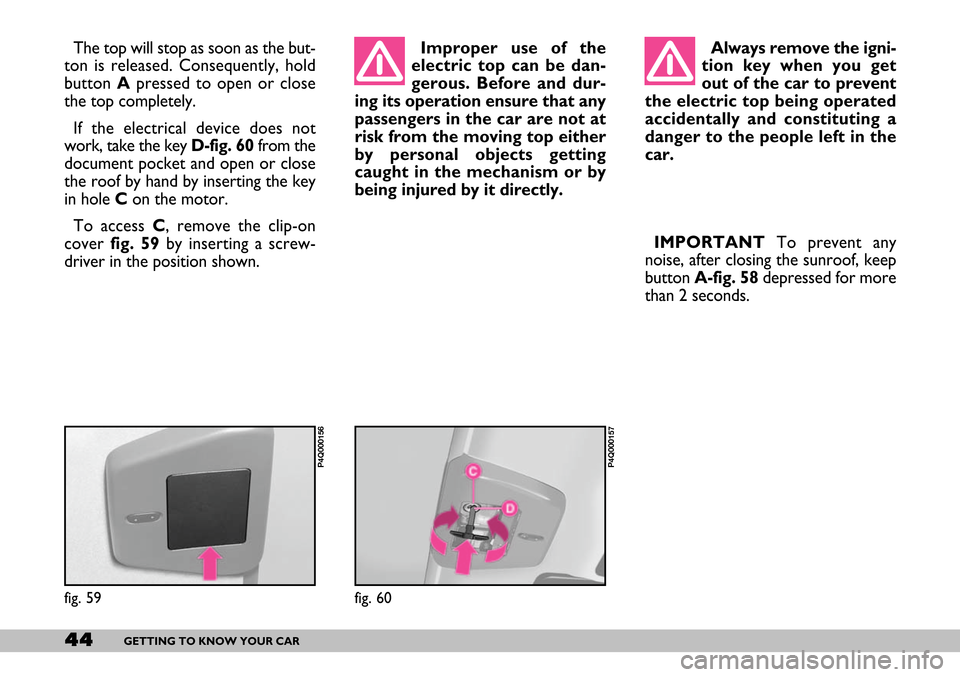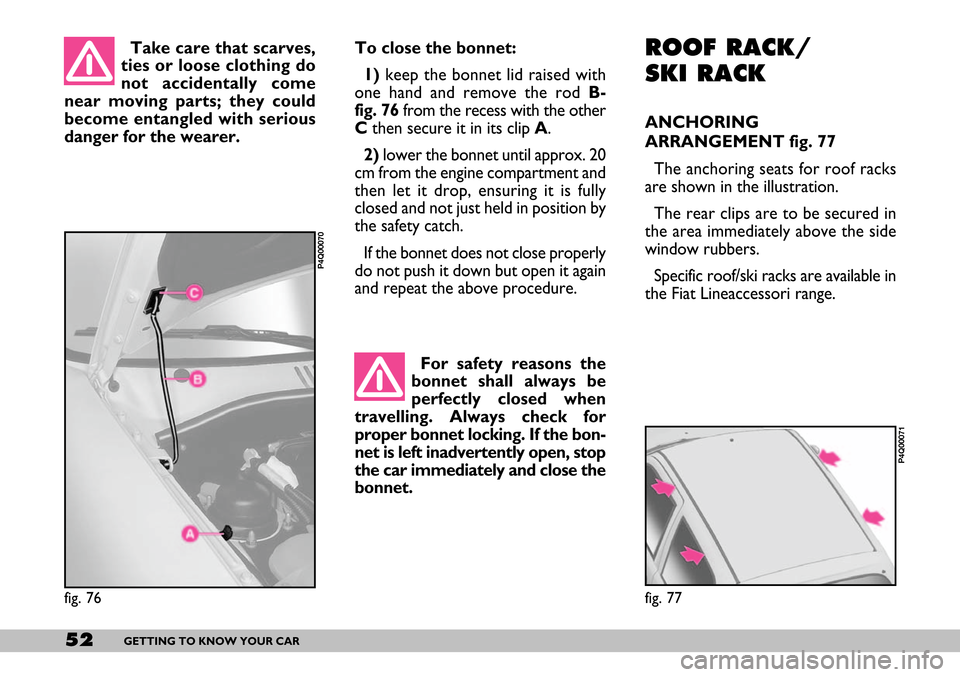2007 FIAT SEICENTO roof
[x] Cancel search: roofPage 44 of 154

43GETTING TO KNOW YOUR CAR
SUN VISORS fig. 55
These are positioned to the sides of
the rear-view mirror. They can swing
up or down or be pivoted sideways.
On the back of the drivers sun visor
there is a document pocket, while the
passenger sun visor is fitted with a
vanity mirror.
fig. 55
P4Q00060
SUNROOF
ELECTRICAL
Opening and closing the canvas
top
Do not attempt to open
the roof if there is ice or
snow on it as this may
damage the top.
The car can be equipped with an op-
tional electrically operated canvas top:
– A-fig. 56 top closed
– B-fig. 57 top open.Press the button as follows to open
the top:
– on the front side A-fig. 58to
close the top;
– on the rear side Bto open the
top.
fig. 56
P4Q00063
fig. 57
P4Q00064
fig. 58
P4Q00023
Page 45 of 154

44GETTING TO KNOW YOUR CAR
The top will stop as soon as the but-
ton is released. Consequently, hold
button Apressed to open or close
the top completely.
If the electrical device does not
work, take the key D-fig. 60 from the
document pocket and open or close
the roof by hand by inserting the key
in hole C on the motor.
To access C, remove the clip-on
cover fig. 59by inserting a screw-
driver in the position shown.Improper use of the
electric top can be dan-
gerous. Before and dur-
ing its operation ensure that any
passengers in the car are not at
risk from the moving top either
by personal objects getting
caught in the mechanism or by
being injured by it directly.
fig. 59
P4Q000156
Always remove the igni-
tion key when you get
out of the car to prevent
the electric top being operated
accidentally and constituting a
danger to the people left in the
car.
fig. 60
P4Q000157
IMPORTANTTo prevent any
noise, after closing the sunroof, keep
button A-fig. 58depressed for more
than 2 seconds.
Page 53 of 154

52GETTING TO KNOW YOUR CAR
Take care that scarves,
ties or loose clothing do
not accidentally come
near moving parts; they could
become entangled with serious
danger for the wearer. To close the bonnet:
1)keep the bonnet lid raised with
one hand and remove the rod B-
fig. 76from the recess with the other
Cthen secure it in its clip A.
2) lower the bonnet until approx. 20
cm from the engine compartment and
then let it drop, ensuring it is fully
closed and not just held in position by
the safety catch.
If the bonnet does not close properly
do not push it down but open it again
and repeat the above procedure.ROOF RACK/
SKI RACK
ANCHORING
ARRANGEMENT fig. 77
The anchoring seats for roof racks
are shown in the illustration.
The rear clips are to be secured in
the area immediately above the side
window rubbers.
Specific roof/ski racks are available in
the Fiat Lineaccessori range.
For safety reasons the
bonnet shall always be
perfectly closed when
travelling. Always check for
proper bonnet locking. If the bon-
net is left inadvertently open, stop
the car immediately and close the
bonnet.
fig. 76
P4Q00070
fig. 77
P4Q00071
Page 54 of 154

53GETTING TO KNOW YOUR CAR
After travelling a few
kilometres, check that
the screws securing the
attachments are tight.
Never exceed the per-
mitted weight (see
TECH-
NICAL SPECIFICATIONS). SLANT COMPENSATION
When the car is loaded, it slopes
backwards. This means that the head-
light beam rises. In this case, it is nec-
essary to return it to the correct po-
sition.
The headlight beam adjuster is lo-
cated inside the car on the right side
of the steering column fig. 78.
Position 0- one or two occupants in
the front seats.
Position 1- five occupants.
Position 2- five occupants + load in
boot.
Position 3- driver + maximum per-
missible load stowed in boot.
Be careful not to knock
objects on the roof rack
when opening the tail-
gate.
HEADLIGHTS
ADJUSTING THE
HEADLIGHT BEAM
The correct positioning of the head-
light beams is very important for the
comfort and safety, not only of the
person driving the car but also all
other road users.
This is also covered by a specific law.
To ensure you and other drivers
have the best visibility conditions
when travelling with the headlights on,
the headlights must be set properly.
Have the headlight positioning
checked at a Fiat Dealershipand
adjusted if necessary.
fig. 78
P4Q01016Check the positioning of
the headlight beams
every time you change
the load to be carried.
Page 58 of 154

57GETTING TO KNOW YOUR CAR
Do not apply stickers or
other objects to the
steering wheel or to the
passenger's air bag cover or on
the side roof lining. Never apply
objects on the dashboard on pas-
senger side (e.g. mobile phones)
since they could interfere with
proper passenger air bag inflation
and cause severe injuries. – car wedging under other vehicles
or protective barriers (for
example under a truck or guard
rail);
as it offers no additional protection
compared with the seat belts, conse-
quently, it would be pointless. There-
fore, failure to come into action in the
above circumstances does not mean
that the system is not working prop-
erly.FRONT AIRBAG
PASSENGER SIDEThe passenger side airbag was de-
signed and calibrated to protect a per-
son wearing seat belts.
When fully inflated, the bag will fill
most of the space between the dash-
board and the passenger.
Manual deactivation
The passenger side airbag can be de-
activated if it is absolutely necessary
to carry a child in the front passenger
seat.
Turn the specific control switch un-
der the middle of the dashboard be-
tween the sound system compart-
ment and the oddment compartment
fig. 81with the ignition key to deac-
tivate the airbag. SERIOUS DAN-
GER: Never place
cradle child’s seats
on the front passenger seat of
cars fitted with passenger air bag.
Air bag activation could cause se-
rious injuries, even mortal. In the
case of need, always deactivate
the passenger’s air bag when a
child’s seat is placed on the front
seat. The front passenger’s seat
shall be adjusted in the most
backward position to prevent any
contact between child’s seat and
dashboard. Even if not compul-
sory by law, you are recom-
mended to reactivate the air bag
immediately as soon as child
transport is no longer necessary.
fig. 81
P4Q00183
Page 65 of 154

64GETTING TO KNOW YOUR CAR
AERIAL
To install:
1)Remove the plastic cap A-fig. 85
screwed onto the car roof.
2)Screw in the aerial. SOUND SYSTEMSTANDARD SYSTEM
The system (all versions) consists of:
sound system power wires, front
dashboard speaker wires, aerial wire,
sound system housing, front speaker
housing.
The radio should be installed in the
compartment occupied by the object
tray which can be removed by releas-
ing the two retaining tabs A-fig. 84.
The power supply, speaker connec-
tion and aerial cables can be found in
this compartment. Contact a Fiat Dealer-
ship if you want to install
a sound system after pur-
chasing your car. Their staff will
advise you on how to safeguard
the life of the battery. Excessive
idle intake can damage the bat-
tery and invalid the battery war-
ranty as well.
Large oddments compartments in
the dashboard making the passenger
compartment even more comfortable
are found in cars not equipped with a
SOUND SYSTEM SET-UP.
A specific
SOUND SYSTEM SET-UPkit
can be found in the Lineaccessori Fiat
range.
fig. 84
P4Q00128
fig. 85
P4Q00075
Page 67 of 154

66GETTING TO KNOW YOUR CAR
SPEAKERS
Use the speaker housings on the
two sides of the dashboard.
– fig. 87 left speaker
– fig. 88 right speaker.
1)Unscrew the four screws Band
remove the supporting grid. SET-UP SYSTEM
The vehicle is equipped with the fol-
lowing devices along with the standard
system:
– 2 front speakers;
– an aerial to be applied to the roof;
– radio power cables.
SOUND SYSTEM
The complete system consists of the
following:
– system provisions (see previous
paragraph);
– stereo radio and cassette player
with removable front control panel
(for features and operation, see spe-
cific instruction booklet).
fig. 88
P4Q00130
fig. 87
P4Q00129
ACCESSORIES
PURCHASED BY THE
OWNER
If after buying the vehicle, you decide
to install electrical accessories that re-
quire a permanent electric supply
(alarm, satellite antitheft system, etc.) or
accessories that in any case burden the
electric supply, contact Fiat Dealership,
whose qualified personnel, besides sug-
gesting the most suitable devices be-
longing to Lineaccessori Fiat, will also
evaluate the overall electric absorption,
checking whether the vehicle electric
system is able to withstand the load re-
quired, or whether it needs to be inte-
grated with a more powerful battery.
Take care when fitting
additional spoilers, alloy
rims and non-standard
wheel caps: they might reduce
ventilation of the brakes, thus
their efficiency, during abrupt
and repeated braking, or long
downhill slopes. Make sure that
nothing (mats, etc.) gets in the
way of the pedals when they are
pushed down.
Page 79 of 154

78DRIVING YOUR CAR
Tyres
Tyre pressure should be checked at
least once every four weeks: if the
pressure is too low fuel consumption
increases as the resistance to the
rolling movement of the tyre is
greater. In this state, tyre wear is in-
creased and vehicle handling suffers
which will effect safety.
Unnecessary loads
Do not travel with too much luggage
stowed in the boot. The weight of the
vehicle and its trim greatly effects con-
sumption and stability.
Roof rack/ski rack
Remove roof racks and ski racks
from the roof of the car as soon as
they are no longer needed. These ac-
cessories reduce the aerodynamic
penetration of the vehicle and will in-
crease consumption. When having to
transport particularly large loads it is
better to use a trailer.Electric devices
Use electric devices for the neces-
sary time only. The heated rear win-
dow, fog lights, windscreen wipers,
heating system blower require large
amounts of electricity, and as a con-
sequence, the fuel consumption in-
creases (up to +25% in town).
Climate control system
The climate control system is a fur-
ther drag on the engine causing higher
fuel consumption (on average, up to
20%). When outside temperatures
permit, use the vents.
Aerodynamic accessories
The use of aerodynamic accessories
not certified for that specific purpose
can diminish the car’s aerodynamic
penetration and increase consump-
tion.BEHIND THE WHEEL
Starting-up
Do not warm up the engine when
the car is stationary, neither by idling
nor revving up. If you do, the engine
will warm up much more slowly and
increase fuel consumption and emis-
sions. It is therefore better to start
slowly and to keep the engine speed
down.
Unnecessary manoeuvres
Do not give quick bursts on the ac-
celerator when waiting at the traffic
lights or before turning off the engine.
This type of action, like the “double
clutch” are absolutely useless on mod-
ern cars. They only increase fuel con-
sumption and pollution.
Gear selection
As soon as traffic conditions allow,
shift up to a higher gear. Using a low
gear to have a sharp acceleration in-
creases the consumption. Likewise,
using a high gear when this is not
called for increases consumption,
emissions and wear on the engine.